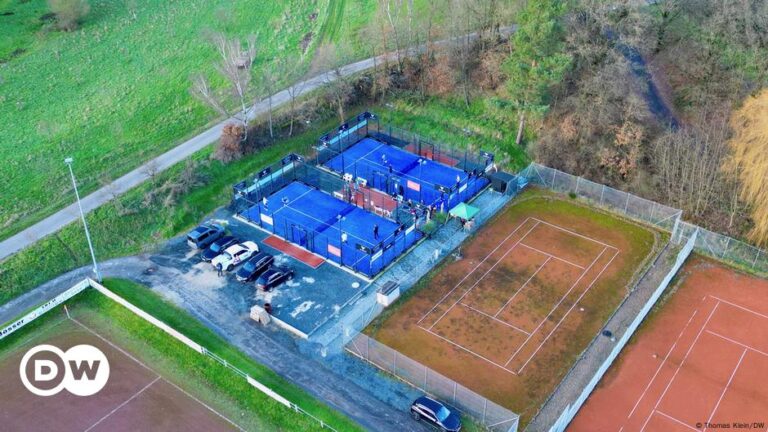The early December cold didn’t deter members of the padel club in Niederwalgern, just over 80 kilometers (about 50 miles) north of Frankfurt, from gathering for the final tournament of the season.
“Padel has become a passion,” said Marco Otto, who took up the new sport about two years ago. He took up this new sport that was more about fun and community than competition. “It’s a fast and dynamic game.”
A little effort can bring a lot of fun
Padel is one of the fastest growing sports in the world. The small court is similar to tennis, with a net in the middle and two service courts, but part of the court is surrounded by glass panels similar to squash, which are incorporated into the game as barriers to deflect the ball. You can. Players use short plastic rackets.
“The biggest difference from other backstroke sports is that you don’t have to invest as much to enjoy it,” youth coach Jan Weitzel told DW. “Padel is easier to learn than other sports, especially for children and young people whose tolerance for frustration is not yet so high.”
Tennis, for example, is much more training-intensive, Weitzel said. With Padel, players can get their first sense of accomplishment in just a few sessions.
tennis doesn’t make a profit
The Niederwalgern club had previously only focused on tennis, and only had new courts built two years ago. However, like other clubs in Germany, this was no longer profitable in the long term as demographic changes were causing problems.
“Our membership structure was outdated, our membership numbers were dwindling, and we had very few new members. As a result, at some point we were no longer able to offer team games and we were unable to offer many training sessions.” said board member Moritz Bremmer. Interest in traditional tennis gradually waned.
Bremer: “At some point, it would have been dead.”
According to the Federal Statistical Office, Germany’s population is getting older on average and the birth rate is falling. This not only affects the labor market and pensions, but also means that many sports clubs are gradually losing ground.
Older members often retire from active club activities, leaving younger members in their place. Streaming services, social media, and video games have become increasingly popular, replacing sports and traditional club activities.
“We could have done well and stayed in business for another 10 years because of the declining membership,” Bremer said. “But at some point, it would have died.”
Because clubs provide spaces for interpersonal interaction and promote a sense of community, inclusion, and social skills, the disappearance of clubs has serious social consequences for society.
“The great thing about club life is the team spirit,” said padel enthusiast Marco Otto. “You meet like-minded people and friendships often develop quickly. We meet and have a great time.”
Clubs take risks and go into debt
This was also the case for Bremer, who moved to Niederwalgern with his family 13 years ago. He enrolled in a tennis club and quickly made friends with the locals. However, the club had to change in order to attract young players.
“We discovered padel as a trending sport,” Bremer explained. “And we just wanted to continue to offer something young, modern and appealing.”
Originally two courts were to be built, but the small club took a financial risk in making the move. “It was an investment worth 10 times our bank balance,” the 41-year-old recalls. But through sponsorship, public funding, and increased membership dues, the money was eventually raised.
Germany’s development is on the right track
For this plan to work, the club needed 30 new members. This community has only 1,400 residents, but that’s a huge number.
But their new courthouse is the first in a 100km radius, and combined with advertising on digital channels and organizing events, the move to padel has been a success.
“Currently, we have 80 members playing padel, about 40 of whom are former tennis players who have switched to padel within the club,” Bremer said, adding proudly. “As a club, we’ve grown by about 30% in the last year.” It’s been two years. ”
Young people in particular are joining clubs and becoming part of the new padel community. Training takes place twice a week, some teams are registered in the second division, and tournaments are held regularly. A nearby comprehensive school’s padel club also uses the club’s courts.
Padel is growing rapidly
Statistics from business consulting firm Deloitte show that padel is rapidly growing not only regionally, but also in Germany and around the world.
According to the 2024 Global Padel Report, in 2016 there were approximately 10,000 courts around the world. Today, there are almost 50,000, and the number continues to grow.
Padel was invented in Mexico in 1965 and was initially developed over time in Europe. But in Spain, padel is the second most popular sport after soccer, with around 16,000 courts and more than 5 million players. The worldwide professional tour has been held for almost 20 years, attracting the best players from Spain and Latin America.
In Germany, on the other hand, the sport is still in its infancy. There are now just under 600 courthouses here, 300 more than in 2022.
This article was originally written in German.


